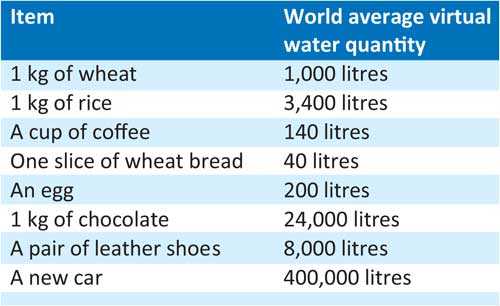Sunday Jan 11, 2026
Sunday Jan 11, 2026
Monday, 22 July 2019 01:26 - - {{hitsCtrl.values.hits}}
When you read the title of this article, you will probably feel disgusted with me as selling our water has been a controversial topic since a long time ago. By the way, I am talking about virtual water trade and you would be surprised to know that we are a water import country despite the immense water resources we possess. 
According to world average annual precipitation data, Sri Lanka is one of the countries which comparatively receives a higher rainfall. Sri Lanka receives about 130 billion cubic meters of water directly from rainfall, but it has been estimated that about 34 billion cubic meters, little more than one-quarter, escapes to sea without being used (P.W. Senevirathne).
When previous governments tried to introduce certain policy initiatives to regulate the use of water resources, perhaps by water pricing, many including the public and social activists opposed and they perceived it as an effort to sell water, which up until then was a free resource. Even the ongoing Uma Oya diversion project was subjected to severe criticism saying that it was an effort to export bottle water to Iran from Hambantota.
In fact, as a country we both export and import water, in the form of embedded water in goods and services produced through international trade, which it is called virtual water trade; virtual water is the measure of total water used in the production of goods and services. Many are not aware of this water trade as it is economically invisible and politically silent. In this way, water-rich countries can help water-stressed countries, where the trade of real water between them is hardly possible due to remoteness and higher water transport costs.
You will be surprised when you see the statistics of enormous quantities of virtual water embedded in many different products which we consume or use. More importantly, these virtual water contents of various consumption items will make people aware of the need for saving this precious resource.
The virtual-water concept was introduced by Tony Allan when he studied the possibility of solving water scarcity problems in the Middle East. He explained that virtual water import is an alternative water source, as water is imported mainly along with food items and it is a concession for water stressed regions.
According to the report of the international expert meeting on virtual water trade that was held at IHE Delft, Netherlands, 12-13 December 2002, Sri Lanka is at the top of the country list that imports virtual water related to the crop trade. According to the statistics based on rough estimates, net water import to Sri Lanka is 428.5 billion cubic meters for the period over 1995-1999. The report further points out that Central and South Asia, Western Europe, North Africa and the Middle East are the regions with significant virtual water import.
On the contrary, United States was at the top as a net water exporting country related to crop trade with net water export of 758.3 billion cubic meters and North America, South America, Oceania, and South-east Asia are the regions with substantial net virtual water export. The story behind these statistics is that, if the net virtual water import is positive, the respective country imports crop items with more virtual water, while it exports crop items with less virtual water.
However, in relation to the international trade of livestock and livestock products, Sri Lanka is ranked 15th in the country list exporting a virtual water quantity of 10 billion cubic meters over the same period, while Australia at the top with 146 billion cubic meters of export. Regarding virtual water imports, Japan is at the top with 112 billion cubic meters in relation to livestock and livestock products.
“As a country we both export and import water, in the form of embedded water in goods and services produced through international trade, which it is called virtual water trade; virtual water is the measure of total water used in the production of goods and services. Many are not aware of this water trade as it is economically invisible and politically silent…You will be surprised when you see the statistics of enormous quantities of virtual water embedded in many different products which we consume or use. More importantly, these virtual water contents of various consumption items will make people aware of the need for saving this precious resource.”
As far as Sri Lanka is concerned, we are at the top of net water importing countries in relation to crop productions. This is a clear indication that we have not been able to manage our water resources effectively for food production. While having abundant water and land resources we are still importing food items from other countries questioning the expectation of self-sufficiency in foods. However, overall net virtual water import of the country is about 5%, while that of Japan is nearly 50%. Hence, the situation of Sri Lanka is not so desperate considering the fact that both countries receive almost a similar amount of rainfall. 
If the quantity of virtual water for certain products are remarkably high, it would be disadvantageous for a country facing water scarcity to export such products and vice versa. The total quantity of water required to produce a certain product depends not only on the production process but the physical characteristics of the environment and water use efficiency as well. Agricultural products are mainly responsible for the movement of water as virtual water around the world as far as the trade volumes are concerned. Further, when compared with water needed for domestic and industrial use, food production consumes a significant quantity. Many countries in the world are now facing water scarcities and, with the impacts of ongoing climate change and population growth, the situation will be further aggravated.
However, there are some shortcomings related to the concept of virtual water as discussed below and therefore, formulation of policies with regard to production of high virtual water intensive products for exporting has to be carefully done after a comprehensive study.
Generally, heavy investments are done for irrigation systems to provide water to agricultural lands. However, when calculations are done on virtual water, all sources of water are given equal economic value, including water received from direct rainfall. Further, it assumes that water used for producing a certain product can equally be used for some other product irrespective of the rate of water use and location. For instance, it assumes that water used for a soft drink manufacturing industry in Colombo can be used under equal conditions for paddy cultivation in Colombo, which is not the case.
Opportunities for Sri Lanka
With the growing trends there will be a high demand for food items from water-scarce countries in the world as they are not in a position to produce water-intensive food products. Moreover, experts suggest that rather than striving for food self-sufficiency, water-stressed countries such as in the Middle East should import food from water-abundant countries.
Therefore, water resources in Sri Lanka can be used as a comparative advantage, if the country can concentrate on the production of export-oriented food products, while importing only goods and services for which we have a comparative disadvantage. However, a more efficient water management with enhanced agricultural productivity is vital for making it a reality, even though we have a vast agricultural potential supported by a large number of reservoirs.
In relation to this, further research should be carried out on the social, economic and environmental implications of virtual water trade, together with policies of overall water management, before it is used as an economic strategy of the country.
(The writer is a charted Civil Engineer)